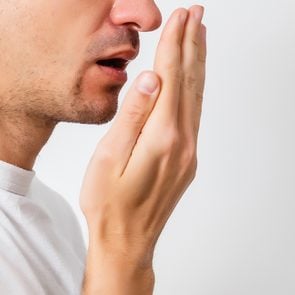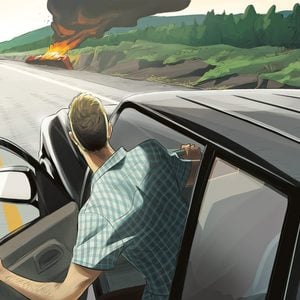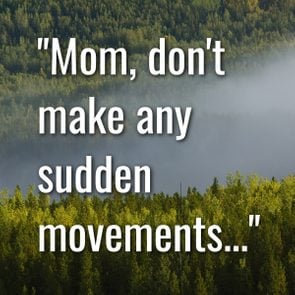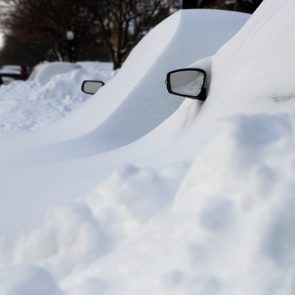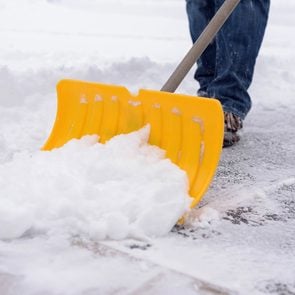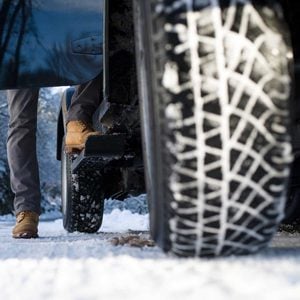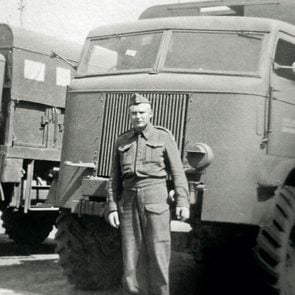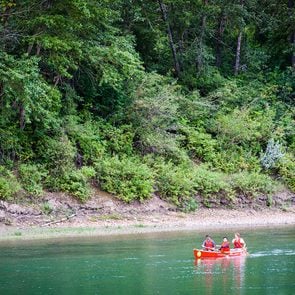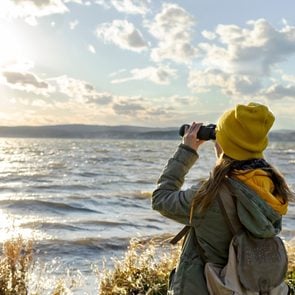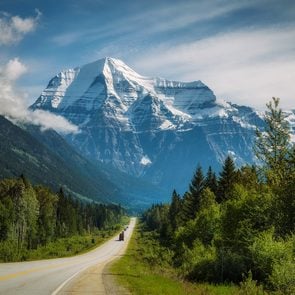If you can’t get to sleep, stay asleep or wake up too early…
These symptoms all fall under insomnia and are usually caused by stress, irregular sleep schedules or excessive use of electronic devices in the evening. Dr. Randhawa suggests three basic strategies:
- Lower your arousal level before bed with relaxation techniques or soothing rituals and routines, such as reading a book or listening to a meditation app. (Check out the best podcasts to help you sleep.)
- Re-establish the bedroom as a calm place to sleep by going to bed only when you’re sleepy, getting out of bed when you can’t sleep and using the bedroom exclusively for your calming routines, sleep and sex. Keep electronic devices out of the bedroom.
- Although it may sound counterintuitive, spend less time in bed. Go to bed later, which increases the pressure on your body to sleep, and then wake up earlier. You might get less sleep the first week, but Randhawa says this will settle down and the quality of your sleep will improve. (Here’s expert advice on how to fix your sleep schedule.)
If you don’t feel rested in the morning…
If you’re sleeping between seven and nine hours a night and are still feeling exhausted and irritable, Randhawa says you should be assessed for sleep apnea at a sleep-disorders clinic. This condition, which affects more than five million Canadians, causes people to stop breathing and wake up for five to 15 seconds multiple times an hour through the night. Sleep apnea is often treated with a CPAP (continuous positive airway pressure) machine, which helps you breathe by keeping the airway open while you sleep. Shedding excess weight and avoiding alcohol before bed may also be effective for mild sleep apnea.
If you sleep too long…
According to Randhawa, oversleeping can be a symptom of depression because the same brain systems involved in causing mood disorders can also disrupt your body’s regulation of sleep. And since regularly sleeping too much—more than nine hours a night—is linked to health problems such as heart disease, type 2 diabetes and obesity, he suggests oversleepers speak to their GP about getting a mental-health assessment.
Next, discover 12 secrets to a good night’s sleep.
Back in the days of yore, leaving your house meant you needed to carry your wallet, which almost invariably contained your cash, a form of picture identification, your insurance card, your credit cards, photos of your kids, maybe even a spare check. These days, you have to ask yourself if you really even need to own a wallet. After all, don’t you have most of that stuff stored on your phone?
And that’s the problem.
The fact is, there are things you should never store in your cell phone—because doing so can leave you vulnerable to an invasion of privacy, identity theft and straight-up theft. Here’s what you need to think twice about storing on your phone.
Your passwords
The irony of passwords is that they’re supposed to make our data secure, and, increasingly, we’re advised to always use a “strong” password and never use the same password more than once. As a result, it’s increasingly difficult to remember passwords without a cheat sheet of some kind. But if you actually use one—especially one you store on your cell phone in the form of a note, a document or even in autofill—you’re putting your data at risk. If you were to lose possession of your phone, someone might easily see your “cheat sheet,” but even if you always have your phone on your person, whatever passwords you store on your phone can end up stored in the cloud, putting your accounts at risk—even accounts that aren’t tied to your phone.
Instead of keeping a list of your passwords or relying on autofill, consider downloading a well-rated password manager such as Keeper, Dashlane or LastPass, so that all of your passwords can be accessed by you using one strong master password.
Find out the password mistakes that hackers hope you’ll make.
Your fingerprint
If you really want to keep your cell phone secure, don’t be tempted into using fingerprint identification to open your phone (or any of its apps or accounts). There are several imaginable scenarios in which someone in your physical presence could force a log-in using your fingerprint. Examples include a thief using physical force or a late-night post-party “prank.” While there is nothing to say a thief couldn’t force you to input your password, the simple fact is that a phone that requires a password to unlock it requires more steps to unlock and is therefore more secure.
In addition, there is always the possibility your fingerprint can be stolen. While it’s a slight risk, the loss would be immense, which makes using your fingerprint something to think twice about.
Your face
Anyone who has struggled with getting their phone to recognize their face when they’re holding their phone at a weird angle might argue that storing your face in your phone as a password alternative is more secure than a fingerprint. While that may be true, when it comes to unlocking your phone, the fact remains that facial recognition is still less secure than simply using a password.
Here are some secrets to steal from people who never get hacked.

Your very personal photos and videos
Maybe you’re really good about maintaining your social media accounts as cleanly and privately as possible, but what about the photos and videos you store on your phone? If you have photos you wouldn’t want your parents, spouse, children, or boss to see, then you shouldn’t store those photos on your smartphone, especially since the contents of your phone may well be stored on the cloud. But if you feel you must store those naughty photos somewhere, then consider storing them not on your cell phone but on a personal computer only you have the password to open. You might also consider storing them in a password-protected album or app.
Find out the three times you shouldn’t accept cookies on a site.
Any photos containing private information
Remember the days when losing your wallet meant reconstructing your whole life to figure out which credit cards and forms of ID you needed to cancel and replace? Now, all you have to do is take a photo of each item and store it on your phone, right? Well, that’s certainly a convenient way to keep track of “what’s in your wallet.” But it can also leave your information vulnerable to hacking, particularly if your photos are stored on the cloud. As with photos you’d rather not see leaked, you might wish to consider storing them on a personal computer only you have access to, and/or a password-protected album or app.
Here are 20 cybersecurity secrets hackers don’t want you to know.
Anything personal if you’re using an employer-issued phone
There’s no such thing as a free lunch. There’s also no such thing as a free work phone. That phone you were issued by your employer comes at a steep price: your privacy. If your employer provided you with a phone to support remote work or for any other reason, you should have no expectation of privacy for anything you do on that phone. For your personal life, the best option is using a separate phone and phone number. One budget-minded option is a burner phone.
You’ll want to change your settings if you use any of these weak passwords.
Your online bank account
If you think online banking is the greatest thing since sliced bread, you’re not alone. Nor are you wrong to think so. But the convenience online banking affords—the ability to bank anywhere, anytime—comes at a cost: your privacy. Carrying your bank account with you on your phone means that you’re risking losing control of it in the event you lose your phone…or even lose track of an old phone that you no longer use.
To manage the risk, you might consider avoiding doing your online banking on your phone. Instead, do it on a computer that never leaves your home. If you find that you simply must take your online banking with you wherever you go, just be sure to use a strong, unique password to unlock your banking app.
Find out the 10 online scams you need to be aware of—and how to avoid them.
Your home address
Storing your home address on the navigation apps you use most makes getting home from anywhere super-easy and convenient. But it can also leave you vulnerable. If a thief ends up with your phone in their physical possession, they can simply click on Waze or Google Maps and see what you’ve stored as “home,” or “work,” for that matter. It is also not inconceivable that your home or work address could wind up hacked or otherwise leaked. If you like keeping those addresses handy so you don’t have to re-input them time and time again, then at least make finding your home or work address a bit more challenging to would-be criminals by giving them a code word as an identifier, like “gym.”
Next, find out why you need to stop commenting on those viral Facebook memes.
Dalai Lama Quotes About Compassion
“If you want others to be happy, practice compassion. If you want to be happy, practice compassion.”
True change is within
“True change is within. Leave the outside as it is.”
Accept everyone as a friend
“I accept everyone as a friend. In truth, we already know one another, profoundly, as human beings who share the same basic goals: We all seek happiness and do not want suffering.”
Perfection
“Within all beings, there is the seed of perfection.”
Changing for the better
“We can deny everything, except that we have the possibility of being better.”

A pragmatic choice
“If at the beginning and end of our lives we depend upon the kindness of others, why in the middle of our lives should we not act kindly toward them? It is the pragmatic choice.” (These powerful acts of kindness will inspire you to pay it forward.)
Powerful actions
“Compassion is by nature gentle, peaceful, and soft, but it is very powerful.”
Tolerance
“It is the enemy who can truly teach us to practice the virtues of compassion and tolerance.” (Here’s expert advice on how to become a more compassionate person.)
Inner contentment
“In order to be happy, we must first possess inner contentment—and inner contentment doesn’t come from having all we want, but rather from wanting and appreciating all we have.”
Planet Earth
“Because we all share the small planet Earth, we have to learn to live in harmony and peace with each other and with nature. That is not just a dream, but a necessity.”
New friends
“Old friends pass away, new friends appear. It is just like the days. An old day passes, a new day arrives. The important thing is to make it meaningful: a meaningful friend, or a meaningful day.”
If you enjoyed these Dalai Lama quotes, be sure to check out this collection of 50 inspirational quotes to live by.
Wellness trends come and go, but one thing that we always assumed was in style was good hygiene. Now we’re starting to wonder, given that the topic of showering—or not showering, as the case may be—is being hotly debated on social media and by celebrities. Quite a few have ‘fessed up and say they have no problem skipping the daily ablutions.
One is actor Jake Gyllenhaal who told Vanity Fair he finds bathing “less necessary” at times. On Dax Shepard’s podcast, “Armchair Expert,” Mila Kunis and husband Ashton Kutcher said it wasn’t really a top priority for themselves or their kids. (Meanwhile, actors The Rock and Jason Momoa came out as shower fans on social media and in interviews.)
Is skipping a shower as gross as it sounds? But even more importantly, does it really have an impact on health? Well it can, according to Annie Gonzalez, MD, a board-certified dermatologist at Riverchase Dermatology, in Miami. Thanks to built up dirt and sweat, some consequences of not showering enough include body odour, acne breakouts, dead skin buildup, fungal infections, and oily hair, according to Dr. Gonzalez. “Not showering enough can also increase the likelihood of getting sick,” she says. (Never ignore these four skin changes.)
Of course, there’s nothing wrong with skipping a shower now and then. And there are some risks to overdoing cleanliness and hygiene, too. To find out how often is often enough when it comes to jumping in the shower, we asked Dr. Gonzalez and another expert some questions. Although there’s no one-size-fits-all answer, the pros share their insights to help you determine what’s best for your body.
What determines how often you should shower?
How often you should shower depends on a few things, according to germ expert Philip Tierno, PhD, a microbiologist at NYU Grossman School of Medicine. Here are some things to consider.
Activity level
One variable that determines how often you should shower is your activity level, according to Dr. Gonzalez. “If you are someone who engages daily in sweat-inducing activities, you will likely need to shower every day,” she says. People who exercise regularly should shower regularly, or at the very least freshen up post-workout until they can bathe. “However, if you don’t participate in any physical activity during the day, it may be unnecessary for you to shower each day.”
There are a few skin conditions you can get or worsen from not bathing or showering. One is dermatitis neglecta, where you get brown patches on your skin made up of dirt, oil, and dead skin cells. If you hit the gym and opt not to shower, you could also increase the risk of getting an infection. One example is impetigo, a contagious bacterial skin infection that causes red sores. Another is ringworm, a contagious fungal infection that is easily spread not only by skin-to-skin contact, but by touching infected surfaces or objects. The symptoms are scaly, red and itchy skin. Plus, the same type of fungus also causes athlete’s foot, too. (Discover the signs of disease your feet can reveal.)
Sweat and body odour
Some people sweat more than others, whether or not they participate in physical activity. So, similar to how active you are, how much you sweat in general is another way to determine how often you should shower. “Some people don’t perspire as much and don’t have heavy odours,” Tierno says. “And they could get away with showering less often.”
“A lot of people don’t use deodorant of any kind, and they would be more likely to have an odour after a few days,” he says. “So it would almost be required to bathe at a particular frequency dependent upon the individual.” In short, the more you stink, the more often you need to bathe, that is, if your body odour is a concern to you (and others around you).
Skin type
Another contributing factor is your skin type. If your skin is on the oily side and is prone to acne breakouts, showering every day would be wise, according to Dr. Gonzalez. But you should only shower a few times a week if your skin tends to be dry and flaky so that you don’t deplete the oils of your skin further.
People with dry skin who shower too often may irritate the skin barrier leading to even more dryness and redness. Those with skin conditions like eczema or psoriasis may also experience irritation if you overdo showering. If you have a skin condition, your doctor might recommend showering less often, and using cool or lukewarm water to avoid irritating your skin.
The season
People adjust their showering frequency with seasonal change. “The summer brings hot and sticky weather, which often causes body odour,” Dr. Gonzalez says. “However, winter leads to drier skin.” Those living in humid or hot climates may opt to shower more often since they likely sweat more, too.
How well you clean your butt
Tierno isn’t holding back: cleaning your butt, or wiping away as much fecal debris around the anus as possible, is an especially important task between showers. And knowing how to wipe your butt well helps people prolong or extend their time between showers, too. “The idea is to make sure people wipe their anus in an appropriate way,” Tierno says. “That’s a very important aspect of maintaining good hygiene.” (Here are nine things you had no idea were actually covered in fecal matter.)
Following an initial wipe, consider doing double duty to cleanse the area. Use wet tissues with either a saltwater solution (1/2 a teaspoon to 1 teaspoon in a quart of water) or even a mild soap solution, to clean the area well. Anal wipes are also an option, too. (This practice isn’t a bad idea, even if you do prefer to shower daily.)
“In a pinch, you can use wet tissue with plain water, but the plain water shouldn’t routinely be used because it can be irritating,” Tierno adds.

So, really, how often should you shower?
There is no generic rule about how often you should shower, according to Dr. Gonzalez. It mostly comes down to personal preference. “Some people feel that showering every day is a must, and some people believe that showering two to three times a week is sufficient,” she says. In general, male or female, it’s OK to skip a day or so depending upon the circumstances, according to Tierno. “Alternating your bathing every other day is perfectly fine,” he says. “There’s no one size that fits all, unfortunately.”
It’s not going to hurt to engage every day or every other day if you so choose, according to Tierno. However, Dr. Gonzalez does suggest showering no more than once a day to keep skin at its healthiest. (These are the best foods for healthy skin that glows.)
Focus on cleaning these parts
How often you shower is as important as how well, and where, you’re cleaning. So it makes sense that Dr. Gonzalez recommends focusing on cleaning the dirtiest parts of your body. These areas include the underarms, in between your toes, the groin, the hair, and the breasts, per Dr. Gonzalez. “Any crevices in the skin should also receive extra attention in the shower as they get the grimiest and sweatiest,” she says.
People who need to shower more (or less) often
Since most teenagers participate in physical activities, they are the age group that should be showering most frequently, according to Dr. Gonzalez. Plus, teens beginning puberty experience an increase in body odour. Meanwhile, children and older adults do not necessarily need to shower as often as teenagers to maintain their cleanliness, Dr. Gonzalez notes.
And of course, individuals who engage in work where they come into contact with debris or germs, such as custodians, garbage collectors, and butchers, may want to shower more often than those who remain in an office all day. (Here are 14 diseases you can prevent just by washing your hands.)
The bottom line
When it comes to the right amount of showering, once a day or every other day seems to be the rule of thumb. But remember, more isn’t always better when it comes to showering. Overdoing it could lead to dry, itchy skin.
Tierno’s best bit of advice is to remember that you know your body best. Only you can determine exactly how much cleaning your skin tolerates and needs.
Next, check out the showering mistakes you didn’t know you were making.
Monday, May 30, 1983, was a holiday in the United States—Memorial Day—and 20-year-old Sherry Vyverberg of Rochester, New York, decided to spend it at Niagara Falls with friends. Tall, with blue eyes and long, fair hair, Vyverberg had just finished a year of community college, the first step toward a nursing degree. Since she had to be back in Rochester by 3 p.m. for her job as a nursing assistant, she left home early and picked up her boyfriend, Keith Gandy, 22, and their friends Greg Grant, also 22, and Mike Jarocki, 26.
It was a bright, cool day, and all four were in high spirits. After a 90-minute drive, they crossed the Rainbow Bridge and had breakfast at a restaurant on the Canadian side of the border.
At 8:15 a.m., they drove along the Niagara Parkway and parked beside the Toronto Power Generating Station, an abandoned generating plant on the west bank of the Niagara River, 580 metres upriver from the falls. Gandy had broken his ankle a week earlier. Now, with his leg in a knee-high cast, he stood leaning on crutches beside the stone powerhouse, talking with the other two men.
Meanwhile, Vyverberg, dressed in a pink track suit, stepped around a metal railing by the powerhouse and crossed a small patch of grass to an ornamental barrier with a 60-centimetre-wide concrete ledge overlooking the water. Then, to get a closer view of the river, she walked a few metres along the ledge.
From her precarious perch, she looked downriver, where the semicircular crest of the Horseshoe Falls spanned the width of the river, from Goat Island to the Canadian shore. Dropping close to 60 metres to the furious turbulence below, the enormous waterfall roared like muffled thunder as it threw up its perpetual cloud of spray. Vyverberg knew that the Niagara was one of the most spectacular rivers in the world. What she did not yet realize was that it was also one of the most dangerous.
Directly below her, six metres down, water spilled from the sluiceway of the old powerhouse. Vyverberg peered down at it. Suddenly, she lost her footing and fell from the ledge.
She felt the shock of plunging into eight-degree-Celsius water and the force of the current sucking her deep down. Somehow she managed to hold her breath underwater and, when she reached the surface, to gasp for air. But again and again, the churning water pulled her under.
On the bank near the ledge, Jarocki had seen Vyverberg lean forward and then topple headfirst. This isn’t real, he thought. He cried, “She’s in!” With Grant, he scrambled down the bank and stood on the shoreline watching helplessly. For an instant, Vyverberg’s head bobbed up, then her feet, then she disappeared under the whitewater. Jarocki thought, There’s nothing we can do. How can we tell her mother?
From the bank, Gandy yelled, “She’s downstream!” Vyverberg had been caught by the river’s current and pulled 15 metres offshore. Now she was roughly 500 metres from the brink of the falls. Through she was a keen skier and hiker, Vyverberg could scarcely swim. Paddling with her hands to keep afloat, she felt the current tugging at her legs like some powerful monster. I’m going to die, she thought. I’m going over the falls.
With Jarocki close behind him, Grant scaled the cliff and raced along the bank, stripping to his underwear as he ran. When he drew level with Vyverberg, she was more than 30 metres out, and much closer to the falls. He clambered down to the river and dived in, the cold water gripping his body. Grant was able to swim just five metres before being swamped by torrential rapids. I can’t make it, he thought, and struggled back to the shore.
While Vyverberg was being swept downstream, three employees of Canadian Niagara Power were driving along the parkway to the company’s Rankine Generating Station, a working powerhouse halfway between the old Toronto Power Generating Station and the falls. Carpenter Joe Camisa, 55, was at the wheel of their truck, with John Marsh and Pete Quinlin in the cab beside him.
Ironworkers by trade, Marsh and Quinlin were old friends and riggers for CNP, where they slung cables around heavy machinery that needed to be lifted and moved. Forty-year-old Quinlin was married, with four children. Marsh, 37, was wiry, with sandy reddish hair and a moustache. A bachelor, he had always loved sports that tested his swiftness and skill.

As the hydro crew drove past the Toronto Power Generating Station, they saw a young man limping toward them, waving his arm wildly and shouting.
“There’s a girl in the water!” cried Gandy. He had abandoned his crutches and hobbled the short distance to the parkway, hoping to flag down someone who could save Vyverberg.
The three men jumped out and raced to the river. Vyverberg was nowhere in sight. Then, from the asphalt path running along the bank, Marsh spotted her head floating like a beach ball 45 metres from the shore.
“She’s way out!” he yelled to Quinlin. “We’re never going to get her out there.” Sick with helplessness, the two men watched as the swift current carried Vyverberg away. Marsh thought, I’d rather jump in than watch her go over the falls and spend the rest of my life second-guessing myself.
Then he remembered the weir, a curved concrete wall running just below the surface of the river from the Rankine Generating Station to a point 130 metres offshore. The weir was designed to divert water away from the falls and into the turbines under the powerhouse. Vyverberg was now just inshore from the river end of the underwater wall.
Marsh had grown up beside the river. “I fish here a lot,” he told Quinlin. “Out where she is, the current is going to the falls. But if I cast out there, nine times out of 10 my line drifts inside the weir, down by our powerhouse. If she doesn’t go over the wall, she’ll come drifting into the powerhouse.”
Glancing back to the parkway, he saw a police cruiser passing and shouted, “There’s a cop. Flag him down!”
Quinlin waved furiously at the officer and yelled, “Get some help. We’ve got a girl in the water!”
Constable James Caddis of the Niagara Regional Police Service quickly called his dispatcher and asked for fire trucks and rescue equipment. But Vyverberg was now only 245 metres—roughly the length of two football fields—from the brink of the falls, and time was running short.
If the current swept her over the weir, no one could save her. If she drifted with the flow to the powerhouse, as Marsh hoped, they might have one brief chance to catch her before she was carried through the intake gates to the turbines—where she would be cut to ribbons—or over the sluiceway at the base of the weir and on to the falls.
Marsh and Quinlin had so often worked side by side that they instantly acted as a team. Quinlin was tying together two pieces of rope snatched from the back of the truck as they ran toward a narrow stone-and-concrete bridge that spanned the intake stream to the powerhouse. The men scram- bled over a steel picket fence and ran along the walkway. “Stay up! We’ll get you!” they called to Vyverberg. She couldn’t hear or see them, but she floated without struggling as the current carried her inshore.
Marsh told Quinlin, “I’ll go. You’re a family man. This is not the place for you.”

He pulled off his boots, jacket, sweater and shirt, while Quinlin tied one end of the rope to the handrail and the other in a running bowline looped around Marsh’s waist. Wearing only his jeans, Marsh climbed over the rail and dropped three metres to one of the concrete piers that supported the little bridge. He waited a few seconds, then said, “She’s as close as she’ll ever come.”
From the pier, Marsh dived in and swam toward Vyverberg as she drifted toward the weir. About 20 metres out, he’d reached the end of the rope, but he still couldn’t reach her. Swimming as hard as he could to stay where he was, he waited until Vyverberg floated closer, then made a desperate lunge and grabbed her by the hair. Pulling her backward toward him, he flung his arms around her and urged her to stay calm. Vyverberg was so exhausted that she only managed to gasp, “Thank you, God,” and to Marsh, “Thank you, too.”
On the shore, Vyverberg’s friends—and Marsh’s—were holding their breath. They saw Marsh seize Vyverberg and heard him yell, “Keep the rope tight and haul us in!” By now, Camisa and Jarocki were on the walkway beside Quinlin. Tugging together, the three men slowly dragged Marsh and Vyverberg through the water and up against a pier below the bridge.
“Hold it!” said Marsh. “Don’t let her slip back in. I’ve got hold of an iron bar down here. I’ll take the rope off of me and get it around her.”
After Quinlin pulled Vyverberg to safety, he dropped the rope back to Marsh, who slipped it over his head and shoulders and let himself be hauled up.
Vyverberg was in shock after her eight-minute ordeal. Her lips were blue, and her shivering body was numb with cold. As Jarocki flung his jacket around her, she began crying uncontrollably. But she was on her feet and walking toward the parkway with Constable Caddis when the emergency vehicles arrived: the fire-department rescue squad, an ambulance and three police cars. The paramedics wrapped Vyverberg in blankets, strapped her to a stretcher and lifted her into the ambulance. Jarocki climbed in beside her.
On the way to Greater Niagara General hospital, Vyverberg was still agitated. “Who saved me?” she kept asking. “Is anybody else hurt?” If someone has died trying to save me, that’s one thing I can’t live with, she thought. Repeatedly, Jarocki reassured her that everyone was okay.
At the hospital, Vyverberg was treated for shock and hypothermia and kept for two hours for observation and tests. In spite of her ordeal, her temperature and blood pressure were within normal limits, and X-rays showed no fluid in her lungs.
She was resting on a cot when Caddis came back to check her progress. Vyverberg asked her rescuer’s name. “John Marsh,” answered the officer. “And you’ve got a lot to be thankful for, that John Marsh was there.”

John Marsh wasn’t at the scene for long. He shrugged off his only injuries: the rope-burn bruises under his arms and around his chest. If Caddis hadn’t hailed him, Marsh and his co-workers would have driven away without revealing their names.
With self-effacing good humour, Marsh also tried to shrug off the accolades that followed, wondering what all the fuss was about. Among tributes from Canadian and American politicians came a letter from President Reagan commending him for his heroism. Marsh was awarded numerous medals and plaques, including the Carnegie Medal and the Royal Canadian Humane Association bronze medal. He was also awarded the Star of Courage by the Governor General.
As Constable Caddis said: “Just to tie that rope around you and jump into that river takes a lot of guts. One man in a thousand would do what John Marsh did.”
Check out more Drama in Real Life from the pages of Reader’s Digest Canada.
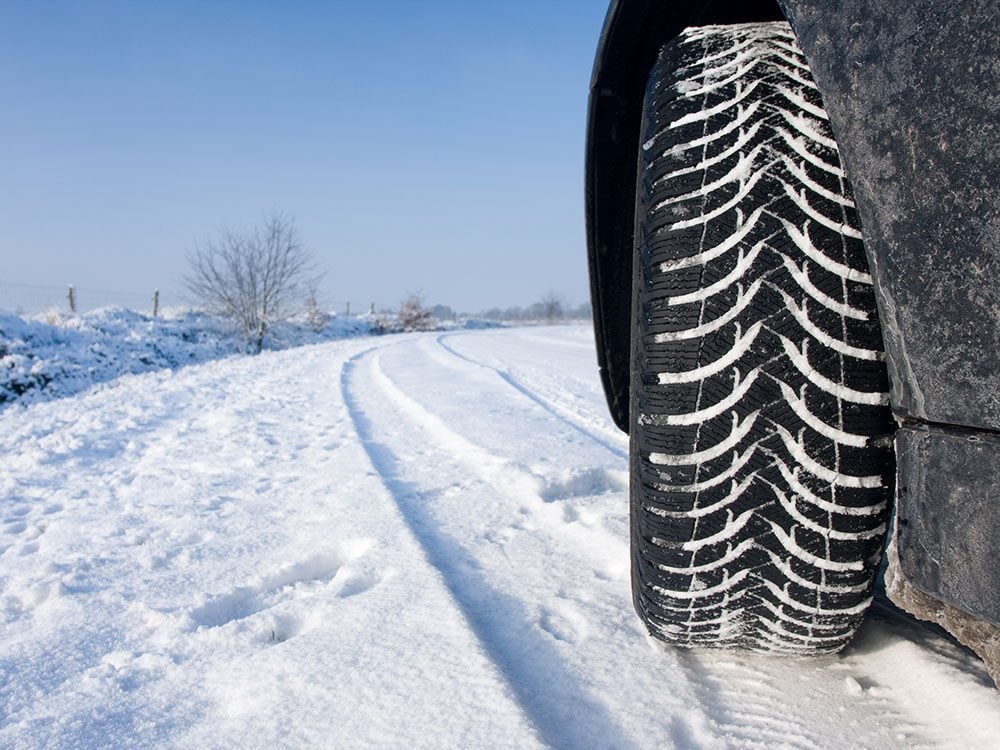
When to change winter tires
Why does it always take the first snowstorm of the year to remind us we really ought to schedule that winter tire change?
Although a majority of Canadian drivers (64%) do indeed change to winter tires every year, 42% of us are doing so at the wrong time, according to a winter safety poll from Hankook Tire.
Jeff Bullock, tire expert and Hankook Tire spokesman, says winter tires are critical to road safety. “Winter tires are made from a high tech rubber material that is designed to perform in cold temperatures,” he explains. “The correct time to change to winter tires is when the temperature drops below seven degrees Celsius. This is the point where your summer tires will begin to lose their grip, may fail to brake and will decline in performance and overall safety. They are not designed to sustain the fierce cold of winter.”
When choosing winter tires, Bullock suggests looking for the snowflake: Winter tires are identifiable as such because they feature a snowflake icon on the side wall. For proper safety, put four winter tires on your vehicle. Trying to save money by just switching out the two front tires is ineffective. Your car needs four of the same tires in order to drive safely in winter conditions.
What’s more, if you’ve had the same winter tires for several years, you might be due for an upgrade. Manufacturers are continually developing innovative new materials that further enhance tire performance and driving safety.
“When it comes to tires, a lot can change in a year from the technology standpoint,” says Bullock. “For example, the winter i*Cept iZ from Hankook is developed with the latest design technology and features interlocking 3D tread with unique features that channel water away from the tire to reduce slipping and hydroplaning. Which means you will have better control over your vehicle no matter how cold and stormy it gets.”
Now that you know when to change to winter tires, find out 20+ things you must do to get your car ready for winter.

Reader’s Digest Canada: Front-door delivery has boomed during COVID. Is this how we’ll all shop from now on?
Carolyn Kim: Statistics Canada has shown that between 2016 and 2020, e-commerce sales by Canadians grew by more than 350 per cent, so the trend of online shopping certainly started well before the pandemic, but of course COVID accelerated that trend.
We don’t have exact numbers for the past two years, but due to this increase, the heavy-duty gasoline and diesel vehicle sector—which includes commercial vans and trucks—is projected to become the largest source of greenhouse gas emissions from transportation in Canada by around 2030. There are currently more than two million of these vehicles on the road in Canada, and that number has increased by about 57 per cent since 2005.
That’s probably why bike lanes are constantly clogged with vans.
Yes. What the pandemic has made clear is that the movement of goods is absolutely essential to our everyday life. So it’s not about figuring out how to stop urban deliveries, it’s about asking how we can better plan our roads.
One option is to create dedicated commercial loading and parking spaces so trucks aren’t double-parking or obstructing the bike lane. Another solution is to help businesses use electric cargo bikes to make deliveries rather than a conventional truck. This is a trend that’s already in practice in Vancouver, Toronto and Montreal.
We’ve seen an expansion of bike lanes in many cities because of the pandemic, which is great. Let’s use that infrastructure for commercial purposes.
Could the use of delivery vans be regulated by municipalities?
Some jurisdictions—such as Santa Monica, California and London, U.K.— are piloting and already implementing low-emission zones. That means defining a certain area within cities where the use of carbon-emitting vehicles, including delivery vehicles, is regulated through restrictions or fees in an attempt to incentivize good behaviour.

There’s also the problem of independent businesses competing with Amazon and other big online retailers. What can be done to make sure they don’t disappear?
We saw local and small businesses quickly pivot to online shopping and curbside pickup during the pandemic. And we’ve seen the e-commerce platform Shopify launch Go Digital Canada, which provides support for small businesses figuring out how to reach their customers online, but we also need government financial and training support to help them adopt new technologies.
In Louisiana, Gotcha—the electric bike and scooter ride-sharing company—gives discounts to small local businesses. They can rent a scooter for $15 a day to deliver goods, and that cuts out the third-party delivery services, which often charge 20 to 30 per cent of the order amount.
Often deliveries go to post office counters inside nearby drugstores. Even though it’s not as convenient as home delivery, is that something that should be used more?
Yes, this is a common practice that could be scaled up to help cities create more efficient urban delivery systems. In Canada we already have UPS Access Point and Penguin Pickup, where people can collect their parcels on their way to somewhere else. Those business models help people be part of the solution by minimizing truck delivery.
Is there anything else we can do to be more responsible consumers?
Oftentimes, customers have the option for a slower delivery at checkout. Going with the slowest delivery window helps businesses optimize their delivery route in the most efficient way possible.
Okay, so patience is a virtue here.
Yes, rather than getting your deliveries within the hour, or same-day.
Next, find out how to outsmart porch pirates.
Few people still pick up phone calls from unknown numbers, but if you do you need to listen closely to what the person on the other end says. If you receive a call and immediately hear the phrase “Can you hear me?,” hang up. The phrase is used to coax you into saying “yes,” a word that, if said in your voice, is as good as gold for con artists.
The person on the other end will be recording the call, and would then use the track of you saying “yes” to access your sensitive information. How? The three-letter word is used frequently by companies to confirm account changes, security settings, and purchases, giving the scammer extensive access to your stuff. (Here are 20 cybersecurity secrets hackers don’t want you to know.)
To avoid these nefarious calls, be wary of unknown or unrecognizable numbers, always keep your personal information private, and don’t be afraid to question the legitimacy of the caller. Although countering back with “Can YOU hear me now?” may seem like the ideal way to really stick it to the scammer, it’s probably best to resist that urge.
Next, find out why you need to stop commenting on those viral Facebook posts.
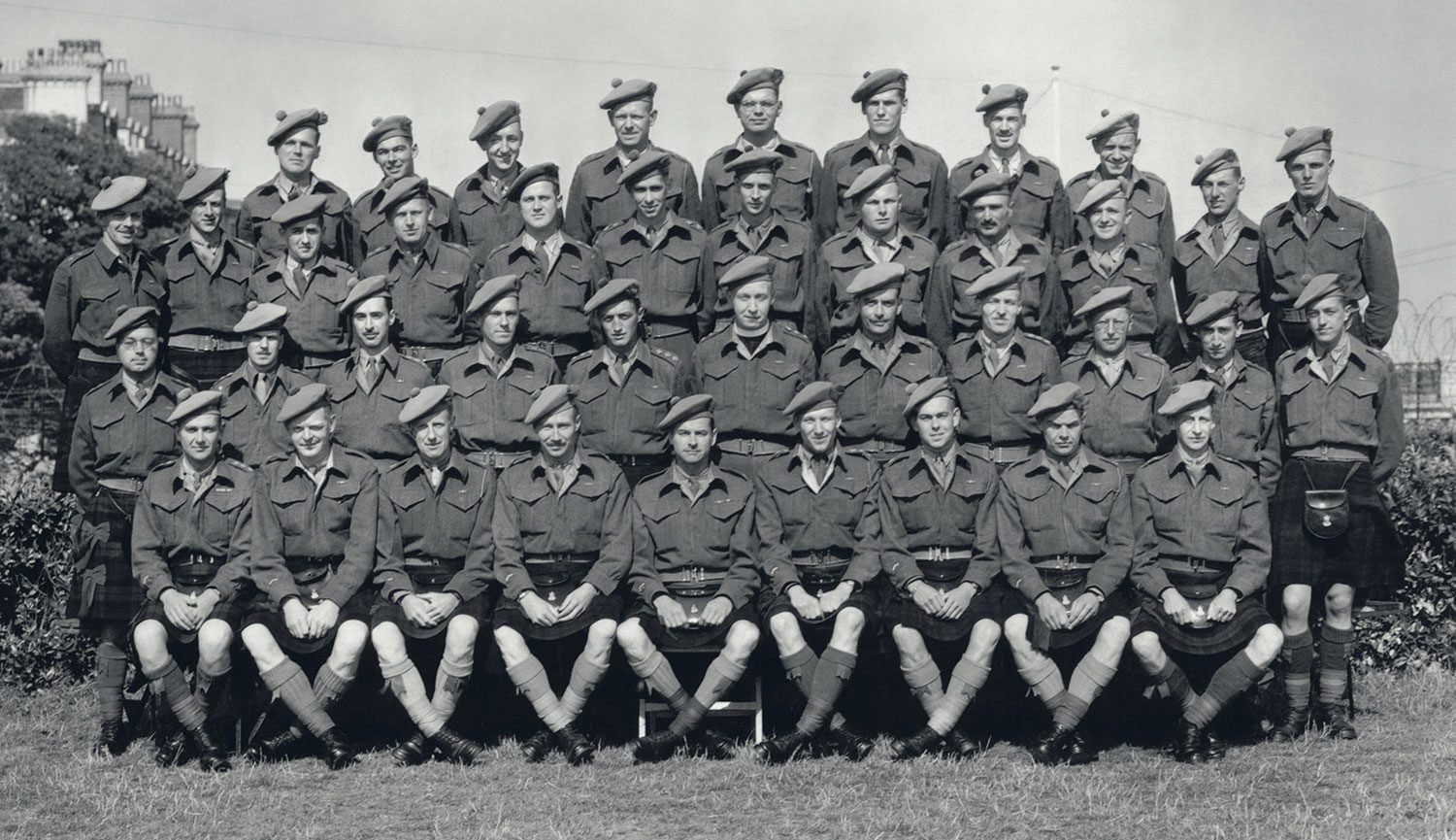
Verrières Ridge, Normandy, July 25, 1944, 0930 hours—H-hour
None of the men in the 1st Battalion of Canada’s Black Watch, the oldest Scottish Highland regiment of the country’s army, had seen the sun for a week when it pierced through a thin veil of overcast to beat down upon their position at the foot of Verrières Ridge. They quickly realized its rays did little to relieve the tension and gut-gnawing dread.
Each of the 320 hollow-eyed, grimy and grim Highlanders, all that remained of four battered rifle companies after a week-long baptism by fire, crouched in a muddied, vacant beet field, waiting for the next move. Their heavy woollen battle dress was smeared with mud, plaster dust, ash and splatters of blood. Sweat-soaked armpits, groins and necklines bore witness to their macabre dance with the unholy trinity of sweltering heat, intense combat and waves of soul-destroying fear.
The Highlanders came from the ranks of the citizen-soldier, men who volunteered to cross an ocean to fight someone else’s war. Known primarily as a Montreal regiment, the Black Watch had drawn its officers from the upper echelons of society and its soldiers from the working-class districts of the city. By the fifth year of the war, however, nearly one-third of the men came from all parts of Canada, the British Isles and Nazi-occupied Europe, and included a contingent of Americans who had joined to get in on the action.
Having learned to take nothing for granted in the moments before battle, some of the men fumbled with buttoned flies or webbed belts to relieve themselves. Others chose to suck back a freshly rolled cigarette or wolf down a slice of hardtack, washed down with a hidden stash of rum, to help steady nerves. Others silently muttered prayers or fondled rosary beads, while those suffering from the vagaries of crushing fatigue built up over the last seven days sat despondent and stone-faced, staring aimlessly. Racked by fatigue that clouded minds, impaired judgment and left them ragged and sapped of strength, some toyed with trading near-paralytic exhaustion for death.
The northern slope of Verrières Ridge, coated now with thick, tall wheat standing shoulder high, rose from beyond a curtain of grain. Shimmering impressively in the prevailing breeze, it accentuated the long, slow and gentle slope that led to the main line of German resistance concealed behind its crest.
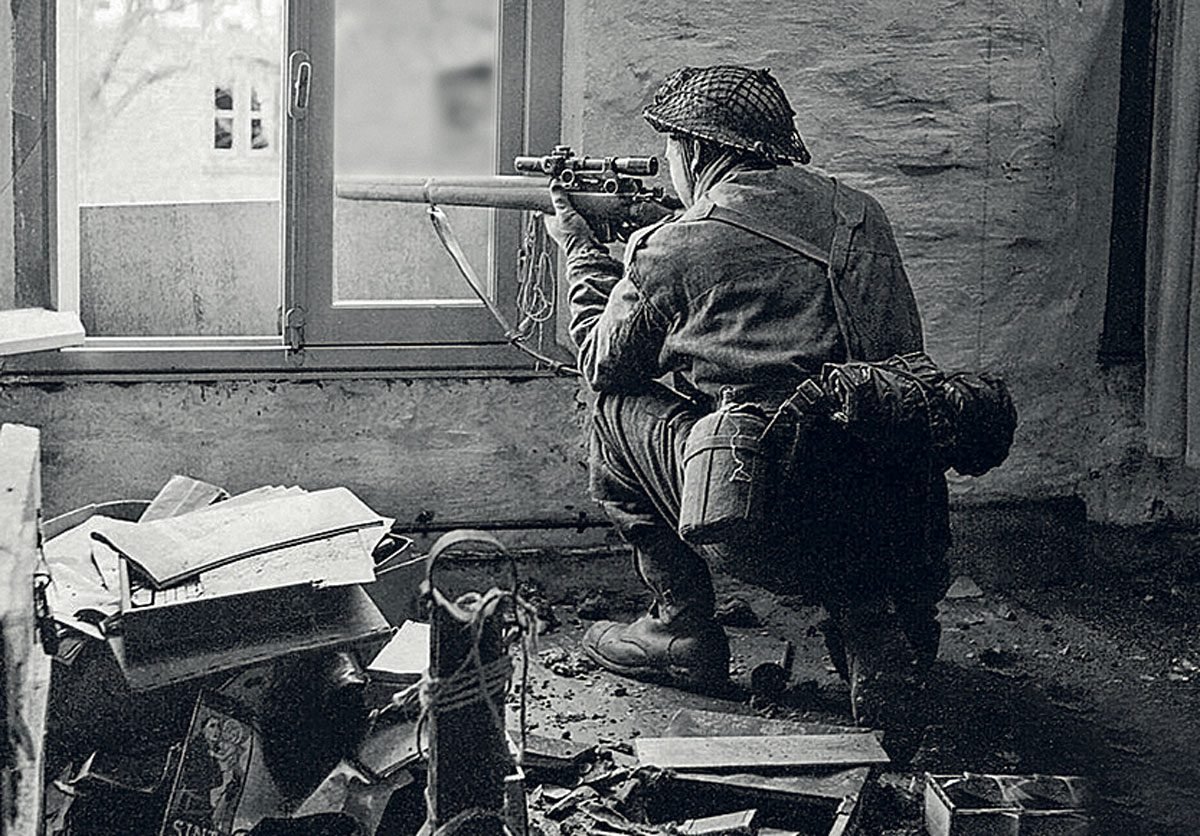
Behind the men lay the evidence of the last four gruelling days and nights. Nine hundred metres back sat Hill 61, a slight rise littered with singed wheat, smashed vehicles and hundreds of abandoned slit trenches. A constant cascade of shells had left the landscape pitted and scarred. The Black Watch had called the hill “home,” sitting exposed to enemy observation, enduring constant German sniper fire and the thunder of rocket, mortar and artillery shells that crashed down in torrents of white-hot steel and high explosive—all while fending off enemy patrols that used the blanket of wheat as cover to infiltrate their lines by day and by night.
In the shallow valley at the foot of Hill 61, spiralling columns of smoke eddied up from the ghostlike ruins of the conjoined towns of St. André and St. Martin. The mining and farming community, which had stood for centuries, had been reduced to rubble, strewn with debris and the scores of unburied dead from both armies. Periodically, muffled explosions from unattended fires erupted, punctuating the strange calm.
Off to their immediate right stood a small cluster of industrial buildings. The Canadians had mistakenly believed it was little more than a factory, unaware of the 365-metre mine shaft that burrowed under Verrières Ridge to the iron deposits below. There, German infantry took shelter from Allied artillery. To dislodge them, it took a liberal dousing of white phosphorus grenades and explosives crammed into ventilation ducts and pithead openings. Now, wall panels and sidings that once flashed in the sunlight stood scorched and blackened, riddled with bullet holes and pockmarked by shrapnel. Doors and window frames hung limply, ripped from their hinges by blasts that left mounds of shattered glass glinting in the sun, guide ropes severed, skips alight and trolleys overturned. In almost every corner, dead and dying German grenadiers lay slumped in grotesque angles on conveyor belts and refuse heaps, while others dangled from power pylons atop the nine-metre-high tipple used to load the iron deposits.
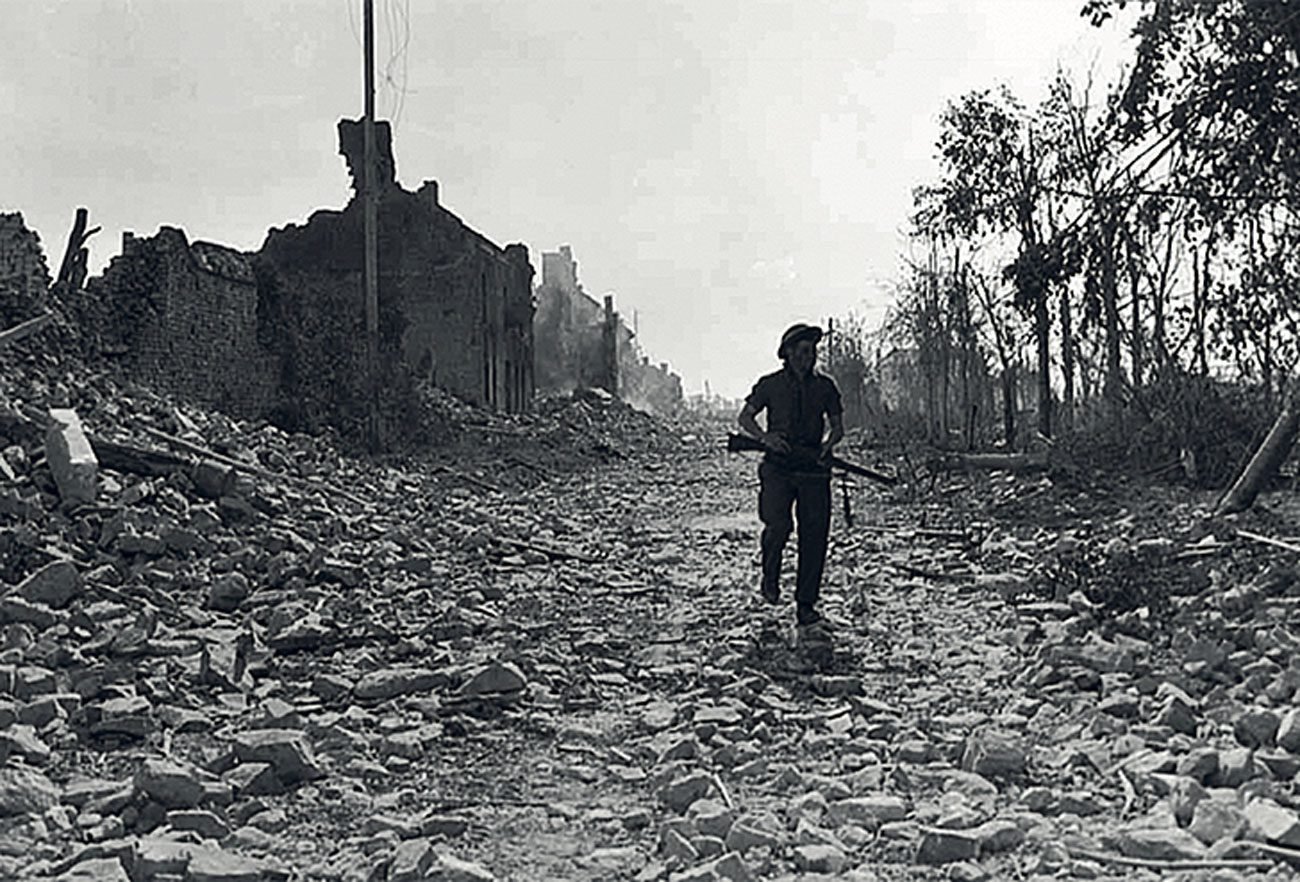
Not a single member of the Black Watch spoke in the beet field—or if they did, nobody remembered later what was said. Nightmares festering from the recent fighting bubbled to the surface and clashed headlong with the soldier’s bid to husband whatever fumes of courage remained for their final assault. They wondered in the backs of their minds if the attack would indeed go on. A series of nasty surprises and fatal encounters with the Germans in St. Martin, which cost the life of their commanding officer, Lt.-Col. Stuart Cantlie, had left the battalion four hours behind the schedule of the tightly timed corps plan code-named Operation Spring. Instead of pushing up the wide-open slopes of Verrières in the haze of the pre-dawn light, they now faced the unnerving prospect of a matinee performance.
None of the Canadians starting up the northern rise of Verrières knew that a veteran force roughly three times their size lay in wait behind the ridge. The villages south of the Norman capital of Caen featured fieldstone houses ringed by high dirt mounds crowned with dense hedges and thickets, all converted by the Germans into fortresses brimming with automatic weapons and anti-tank guns. Each “hedgehog,” as the defenders called them, formed part of a defensive web with interlocking fields of fire supported by artillery, rockets, mortars and battle groups (Kampfgruppen) from elite SS and army panzer divisions.
Getting up the wheat-covered rise that lay directly ahead, however, was their immediate problem. As with previous attacks that week, they expected to have a squadron of Canadian Sherman tanks in support, which would pepper the objective with direct fire from the cannon and machine guns. At the same time, a full regiment of field artillery would drop a steel curtain of high explosive shells 45 metres ahead that would “creep” towards the enemy as the Canadians closed on their line. Off to the right flank, smoke would shroud the battlefield in a great, thick mist, cutting off enemy observation from the heights across the Orne River to the west.
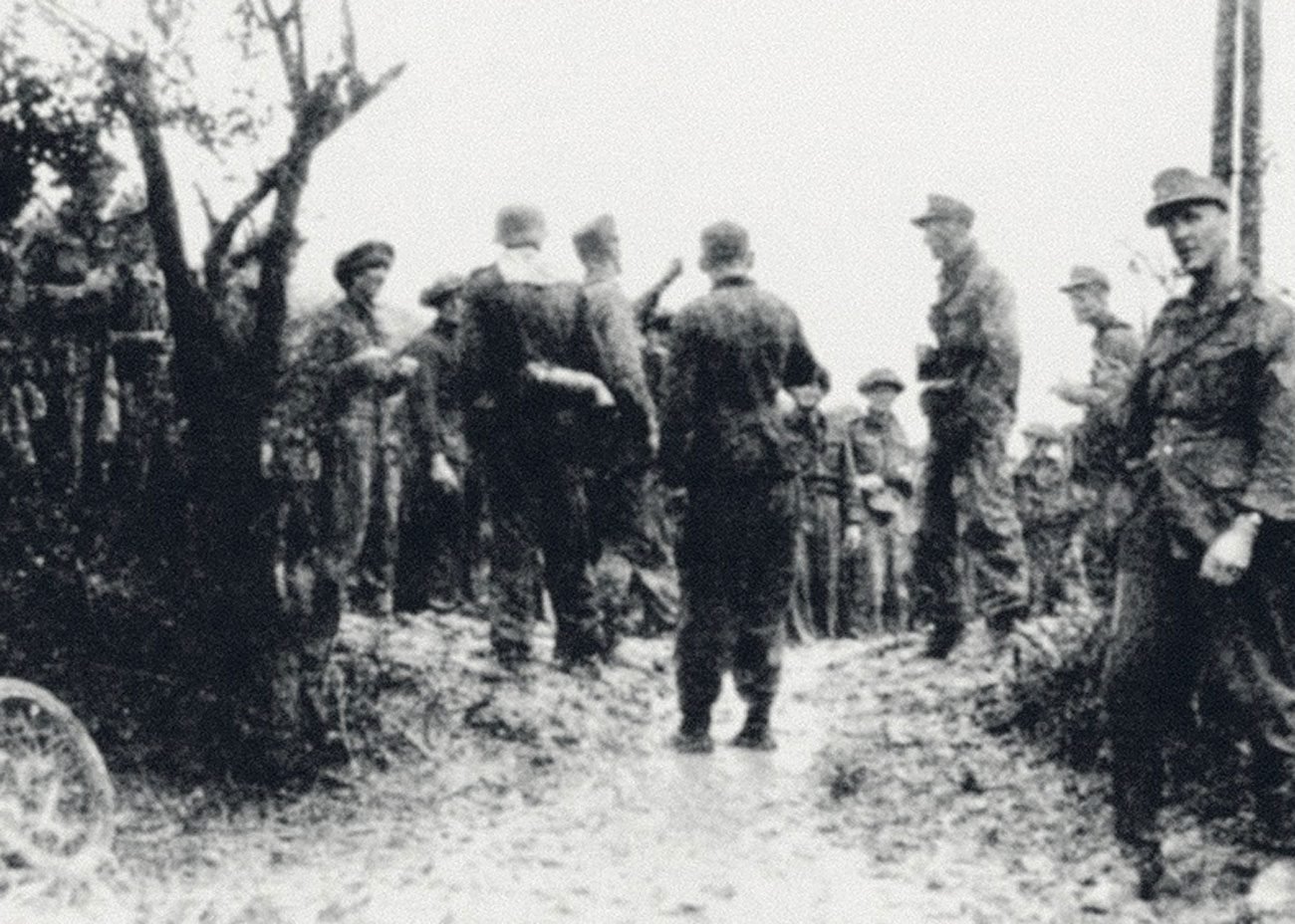
Yet by the time H-Hour arrived, none of these elements crucial for success had materialized. Operating under a direct order to press on immediately, and with regimental pride and honour at stake, Major Phillip Griffin, the 26-year-old acting commanding officer, reached back with his right arm and, after a slight pause, waved it forward. Upon his cry of “Black Watch, advance!” the men rose to their feet in unison.
Clomping through the mud with rifles across their chests at the ready and bayonets fixed, they dipped into the sea of wheat and discovered the going more trying than they’d imagined. Although they had a brief taste of fighting in this type of terrain earlier in the week, nothing compared with this labyrinthine crop blanketing Verrières Ridge.
Cutting telltale paths into the grain, the Highlanders struggled slowly up the gentle rise that in centuries past had hosted the armies of William the Conqueror and King Henry V but now masked a more sinister horde. Spread out in a loose configuration, and carefully concealed in trenches and weapons pits, Wehrmacht and SS panzer-grenadiers, snipers, machine guns, panzers and anti-tank guns, from some of the best units Hitler still had to offer, waited patiently, baiting their quarry into a carefully crafted killing field.
Slogging steadily through the wheat, prairie boys, longshoremen and lumberjacks strode side by side with the wealthy and the powerful. Caucasian, African Canadians and Indigenous men moving seamlessly with Jews and Gentiles, communists and capitalists, conservatives and liberals. The men maintained an unyielding faith and obedience to authority underscored by their devotion to principle, duty, friendship and the ironclad concept of “regiment.”
Forty-five metres into the field, a screen of high explosive and white-hot shrapnel arrived, erasing any notion of escape or withdrawal. In quick succession, German artillery observers, dug in on the crest and the heights across the Orne River valley, zeroed in on the three-metre whip antennas of the battalion’s wireless sets, waving madly above the wheat. In quick succession, the crackle of wireless traffic ceased as German mortar shells found their mark. With communications cut, the men in the Black Watch could not have been more alone.
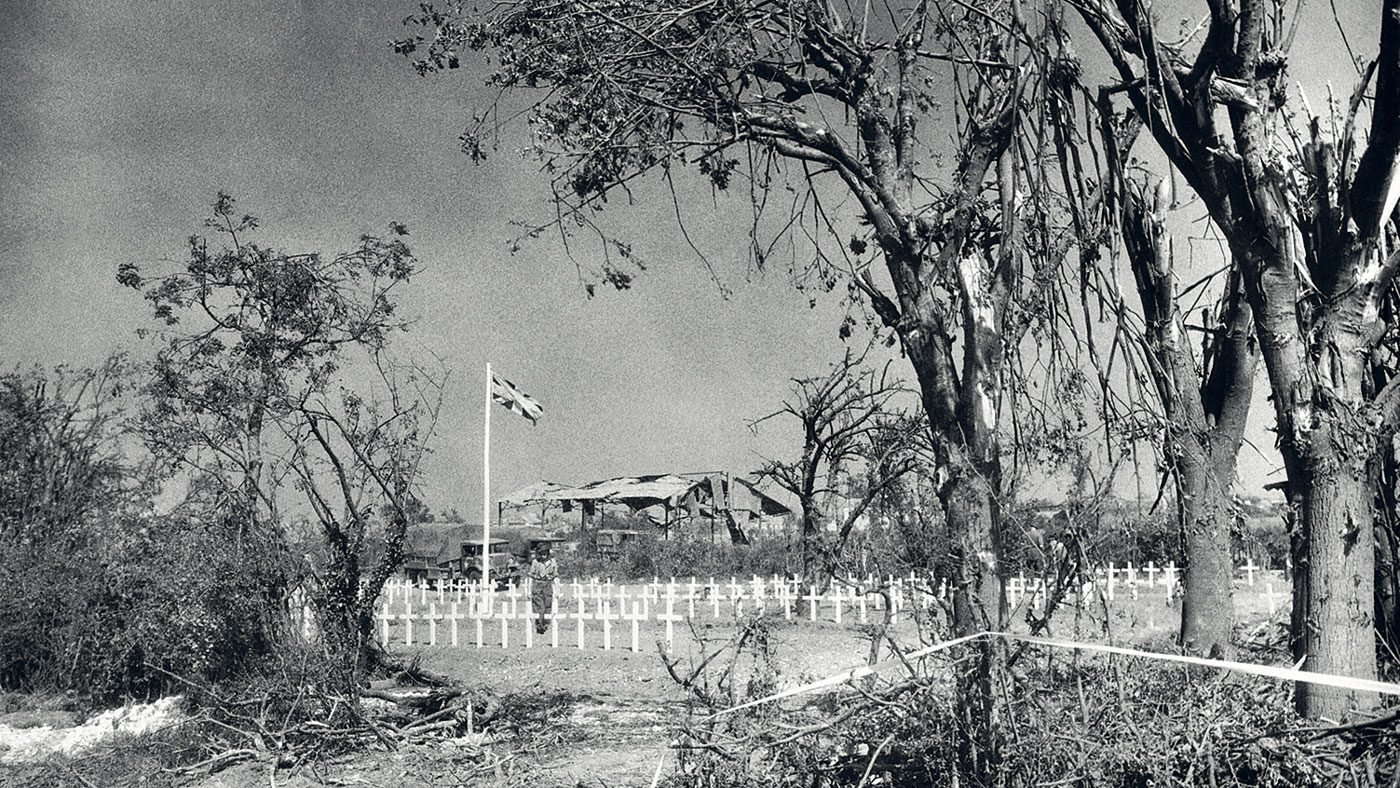
Ninety metres into the field, German machine guns, sitting snugly in camouflaged hides lining the flanks as well as atop the ridge, barked to life. Firing on fixed lines, their bright green-and-yellow tracers ripped into the men from three sides, cutting deadly swaths into the wheat with scythe-like precision, their rounds tearing flesh, tissue and tendons, leaving organs and bones shattered. The Highlanders, devoid of cover, bobbed and weaved in the chest-high grain, each man hoping not to draw the short straw.
One by one, however, they started to fall, swallowed by the wheat that rendered command and control almost nil. The cadence of the few soldiers still left on their feet, once calm and firm, now rose sharply. With no hope of stopping, of withdrawal or of mercy, the soldiers felt an increased sense of urgency. “Stay in step! Keep it together! Keep moving, men. Keep moving forward!”
Any trepidation built up in the moments before the attack had vanished, replaced now by a scorching rush of adrenalin. With their hearts now racing, throats burning and arteries pounding in their ears, only the cries from the wounded and the dying rose above the racket. Once smooth and controlled, their collective glide hastened in pace, turning rapidly into a frantic gallop as they slammed into the German picket halfway up the ridge. Hidden beneath the grain, any defender naive enough to offer surrender received no quarter when the Highlanders overran their slits.
German rocket and heavy artillery fire joined the choir just metres from the crest, and a hurricane of steel and fire greeted the mass scurrying through the wheat. The ordinarily pleasant scent of petrichor, kicked up from the soggy soil with each blast, mixed with the bleach-like stench of cordite, the charcoal-like smell of singed flesh and the sulphuric stink of melted hair. With every step, the ground shook; bodies and body parts flew in all directions, striking those still pushing forward up the ridge.
The only reward for the intrepid Highlanders who reached the crest came in the form of elite panzers and panzer-grenadiers, who opened fire at point-blank range. From beneath the grain, screeches from the wounded and dying, calling out in vain for a medic, a stretcher-bearer or their mothers. In short order, cries turned to whimpers and then, mercifully, irreversible silence.
Drenched in sweat and wild-eyed with rage and terror, the Highlanders who were still on their feet continued to press through the fire and the carnage, spurred on by desperate “do or die” calls from their acting commanding officer, whose repeated pleas to push on rose above the cacophony. “C’mon, men! Keep moving! We can reach the objective.”
Of the 320 men who made the assault up Verrières Ridge on that summer morning in late July 1944, no more than 20 reported fit for duty the next day. The fate of the rest came into sharp focus weeks later when Verrières Ridge finally fell to the Canadians in the second week of August. On July 25, the Black Watch had suffered 94 per cent casualties killed, wounded, missing and prisoner of war—a rate that put them on par with those suffered by the Royal Newfoundland Regiment on the tragic opening day of the Somme in 1916. Most of the 129 men who were killed in the assault are now buried in the Bretteville-sur-Laize cemetery outside the village of Cintheaux. The day would go down as the second costliest for the Canadian Army in the entire Second World War, after the bloodbath at Dieppe two years earlier.
Excerpted from: Seven Days in Hell, published in Canada by HarperCollins Publishers Ltd. © 2019 by David O’Keefe. All rights reserved.
Next, find out how Alberta’s Cree code talkers helped win WWII.

If you are visiting the Grande Prairie region of northwestern Alberta, consider exploring the Kleskun Hill Natural Area. I have hiked through this unaltered collection of beautiful landscapes many times, and each time I felt so thankful for the opportunity. Kleskun Hill allows a breathtaking exposure to the geology of northwestern Alberta. The eroded slopes of the area reveal a distinct geological history similar to that of the badlands in southern Alberta. The exposed layers of sandstone, siltstone, shale and bentonite display a colourful layered pattern that has drawn interest for centuries. Collectively, these layers of soil and rock make up the Wapiti Formation in northwestern Alberta. Along with one of the largest swathes of grasslands in the region, Kleskun Hill has a wide variety of native plants common to Alberta’s Parkland and Prairie areas. Here you can find extensive aspen groves, stands of lodgepole pine and spruce, and a vast collection of prairie grasses and shrubs.

Currently in Alberta, only about one per cent of the original prairie grasslands are under federal protection. As a result, the Kleskun Hill Natural Area offers one of the province’s best opportunities to study a preserved grassland ecosystem.

Archeological evidence shows that Indigenous Peoples have lived in the Grande Prairie area for thousands of years and that the region has been used by members of the Cree, Dane-zaa and Six Nations peoples for hunting and for gathering serviceberries (also known as saskatoons). In addition, over centuries, Indigenous Peoples in the area used the elevation of Kleskun Hill to locate and hunt what was a major food source, the wood bison.

I was fascinated by the beauty and wildness of that landscape. A designated natural area, it has never been cultivated and thus holds a rich collection of flora and fauna. In the Kleskun Hill area we find a disjunct community of plants, birds and butterflies, many of which are also seen in southeastern Alberta’s prairies and central Alberta’s parklands, as well as on the eastern slopes of the Rocky Mountains. Notable birds to spot include the upland sandpiper and the meadowlark. Some showy flowering plants include the western wood lily, the prickly pear cactus, the prairie crocus, wild blue flax and, at times, a plethora of blooming arnica. In this remarkable landscape, I have hiked the trails established by bison and now used by mule deer, moose, black bears and coyotes. In mid- to late summer, the serviceberry population on Kleskun Hill produces a significant crop. This abundance draws black bears to feed on this rich food source.

The County of Grande Prairie maintains Kleskun Hill Park and its campgrounds, and offers outdoor displays of farming memorabilia as well as a museum containing original buildings and some tools used by the early settlers. An early wave of homesteaders began arriving in the Peace River, Spirit River and Grande Prairie areas by 1910. Then, before the railroad was built in 1916, more settlers came overland on the very challenging Edson Trail. On the southeastern flats of Kleskun Hill, there is still a remaining section of the original Edson Trail to Grande Prairie.

As a photographer, I loved hiking in the Kleskun Hill Natural Area for its breathtaking scenery and magnificent landscapes. During the spring and fall, the brilliant colours are impressive. If you decide to visit the Kleskun Hill Natural Area, remember to take your camera, be prepared to cross some fencelines, bring a sturdy pair of hiking boots and throw on some long pants!
Next, explore 10 national parks every Canadian needs to visit.









